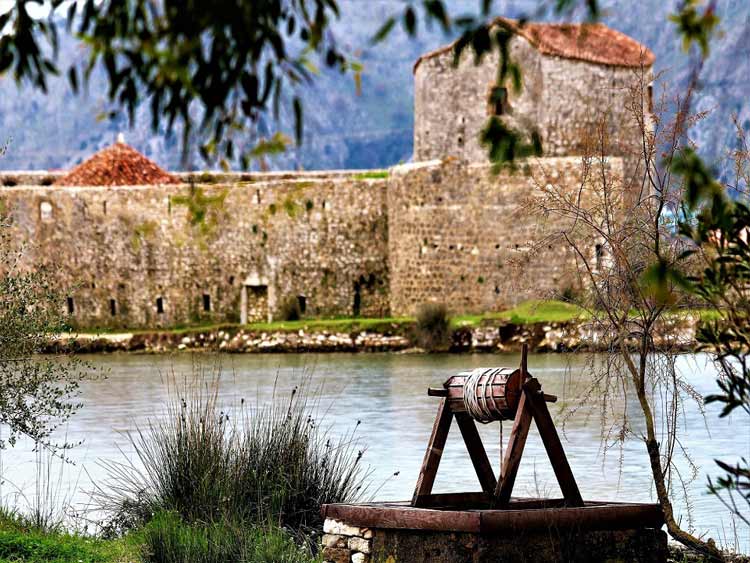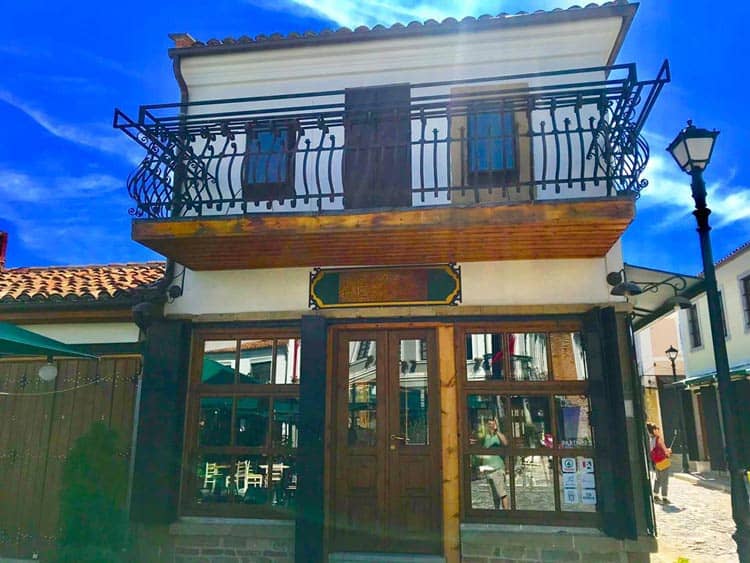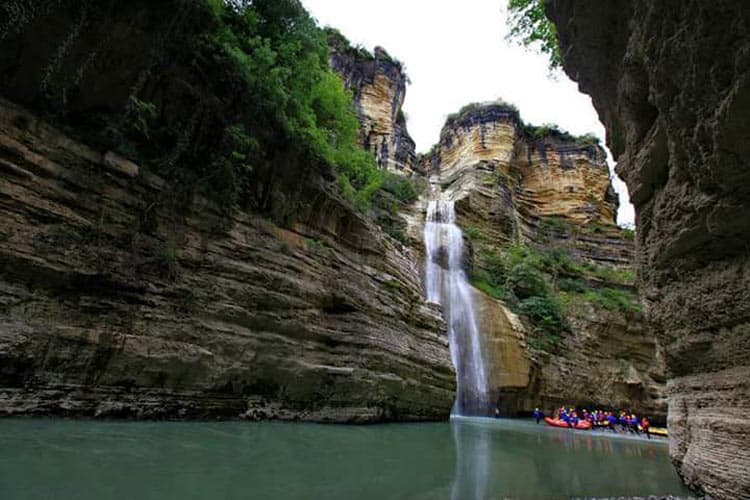

For years, the small country of Albania was cut off from the world, but today, it has become an increasingly popular tourist destination. It attracts beachcombers, foodies interested in unique traditional cuisine, and history buffs looking for rich cultural heritage.
10 Interesting Facts About Albania:
1. In the evenings, the locals like to walk but it’s not just a walk. Known as Xhiro, it’s an official evening walk where residents come out to stretch their legs. In many towns, the roads close to cars during certain hours. Apartment blocks are empty and everyone gathers at various places, walking and talking until nightfall.
2. When an Albanian agrees with you, he or she will shake their head, and when they disagree with you, they will nod. Be warned and avoid confusion. Yes means no and no means yes.
3. Albanians believe that a scarecrow placed on a home or other building while it’s under construction will ward off envy from the neighbors.. Ha! Sometimes you’ll see a teddy bear serving the same purpose. The odd part is that the scarecrow or the teddy bear will be impaled on a rod or hung by a rope-like a noose. Some also say that these talismans bring good luck.
4. When the communist era ended in 1991, there were roughly three million people in the country but only 3,000 cars. Communism isolated the country and, for a long time, only party officers were allowed to use cars. In the years since many more cars have come into the country, and the national preference appears to be Mercedes.
5. The heroine of Albania is Anjezë Gonxhe Bojaxhiu, better known to the rest of the world as Mother Teresa. She was born in Skopje, part of Albania for a long time but, since 1913, part of Macedonia. She is the only Albanian to win a Nobel prize.
6. In 1995 a law was passed requiring citizens to pay taxes on traffic lights in their home towns. The residents of Shkodra were taxed, just like all cities, but they staged a protest. The reason? Shkodra has no traffic lights.
It’s one of the oldest cities in Europe and the fifth-largest in Albania, with a wonderful Old Town worth visiting. History buffs will love the restoration that’s happening. Also, the Rozafa Fortress offers incredible views over the lake.
7. Tirana, the capital of Albania, has a lot in common with other European capitals. It’s one of the only capitals without a McDonald’s (another is the Vatican City). Tirana is the heart of the country with a vibrant and youthful atmosphere. Post-communist transformation is most apparent here.
It’s practically unrecognizable from its old self. Primary colors decorate the buildings, and there are more public squares and pedestrian streets, as well as new business and shopping. Check out Blloku, where there are great bars, as well as the grand boulevard.
8. Albania has over 750,000 bunkers spread out across the land. They are hard to miss and can be a nice car game (be the first to spot the bunker!). They were all built during the dictatorship of Enver Hoxha to protect the country from an invasion – but an invasion never happened.
Most bunkers are a bit of an eyesore and many Albanians dislike them because they are a reminder of 50+ years of isolation. But a few have been repurposed into cultural museums, artistic canvases and business ventures.
9. Tirana, the capital, is surprisingly chic. For a country that’s had some stark years, the true Albanian spirit can be seen in modern Tirana. You might expect it to be dominated by grey concrete (like other post-communist European cities), but there’s a ton of green space, and, of course, lots of color. The inspiration behind the reinvention of the city is Edi Rama, a painter and a politician.
10. Raki is the national drink, but be warned! Raki made out in the villages is equal to about three normal drinks. If you’ve traveled in the Balkans, you’ve probably come across rakija or rakia, but the Albanian version is quite unique.
It’s an old-school moonshine made from grapes and it’s incredibly strong. You’ll find it in most bars but be sure to pay attention to its source. If it comes out of a repurposed plastic bottle or plain glass jug, you’re liking getting a home-brew likely to put hair on your chest (as the saying goes).
Here are a few other things you should know about Albanians:
Respect Places First
Albanians are very hospitable, even more so than in the rest of the Balkans. Elder males expect to be shown respect because of their age. Men of the family have to be respected, in particular. Shake hands with them and do not argue about topics such as religion and politics.
In the north, avoid topics that go beyond local understanding. On the other hand, in Tirana, you will find very cosmopolitan people who are as open to new and modern ideas as citizens of western Europe. Perhaps the most important thing to remember is to respect local people, at least as much as you respect people back home.
Traditions Place Second
Women traditionally kiss one another on the cheeks, sometimes from the very first time they meet, but men and women do not kiss each other on the cheek unless they have been friends for a long time.
If there is a baby in an Albanian family, always ask to see him or her, and don’t forget to add a compliment (usually “qenka i shendetshem, me jete te gjate” or “what a sweet baby” works best). If you are a man, or a woman with a group of men, don’t compliment females unless they are under age 10-12.
If you don’t speak English, but a language where “you” in informal and “you” in formal are not the same, be aware that some Albanians do not use the formal form in their language. Sometimes even the prime minister is addressed with “ti” if a journalist is a friend of his.
However, when meeting people for the first time, it’s better if you address them in the formal form, although they will shortly after ask you to address them in an informal way.
Policemen in Albania are often polite. Police at checkpoints will very often stop foreign cars, many of which are owned by returning Albanians or Kosovars who are good targets for extortion.
When police see that you are a foreign tourist, they will usually tell you to go on (usually with “ec, ec, rruge te mbare” which can be translated to “go on, have a nice trip”). When this happens, it’s very polite if you respond with a “faleminderit” (“thank you” in Albanian).
Albanians love dancing, especially at weddings. If you are attending a party, don’t be afraid to dance. Maybe you don’t know the traditional dances, but try to learn.
Note From the Author
My wife and I are the owners of the Albania Express Travel, a Travel Agency and DMC Balkan Tour Operator with great experience in arranging group tours, individual tours, accommodation and transport. We also link groups with experienced guides in different languages, events and meetings, trekking, hiking and walking tours. Other groups can do holidays to Albania and its neighboring countries such as Montenegro, Macedonia, Kosovo, Croatia, Serbia and Bosnia and Herzegovina.
Albania, once a communist country, had been isolated for 50 years. In the early 1990s, the political system changed, and today we live free. But after communism, Albania became very poor and many Albanians fled the country for a better life. I did the same thing.
I moved to England for 10 years and then returned to Albania. In England, I met my future Albanian wife, Alma, and in 2012 we decided to return and start a tourism business in Tirana, the capital of Albania. Alma and four other women work in the office, returning calls from clients, organizing tours, figuring out prices, and the like. I deal with hotels, guides, transportation and I also am an English language guide. I don’t like working in the office, so I’m on the move all the time. We only do tours in Albania and the Balkans.
During communism in Albania, the only foreign languages we were allowed to learn were those of communist states, like Russian or Slavic languages but I was lucky, because my neighbor, a woman married to an Albanian doctor, spoke English very well. I learned a lot from her in secret, because if someone from the communist party had found out that I knew English, they would arrest me and my teacher, even though I was only ten years old.
When the system changed, the opportunity for work was great, because in Albania very few people knew English. I started working in some foreign embassies in Albania, including the English embassy, and I was given the opportunity to live in England for a while. Even today we have very few people in Albanian tourism who speak foreign languages but Albania is ready for exploration, and millions of tourists come to visit the country. I am very much in demand because I speak English,
If you do find someone who speaks English in Albania, they don’t always know the history or geography and if you find someone who knows the history, he or she cannot drive or don’t have a license.

I have all of them. I speak English, I know the history of my country, and I have some cars and minibuses. I am fully booked the whole year.
We have clients from all over the world, but Italian tourists are No. 1 right now because Italy is very close to Albania and 70 percent of the population in Albania speaks Italian. Why? Albanians created special TV antennas to get reception from Italian TV channels and Albanians learned Italian secretly through the TV.
During the night, if the lights were on in your house, the police arrived and asked why you weren’t sleeping. After 10 o’clock lights had to be off but people put some blankets over their windows to stop the light from reflecting outside the house and watched Italian channels.
To learn more or book at tour, reach us at Albania Express Travel



























